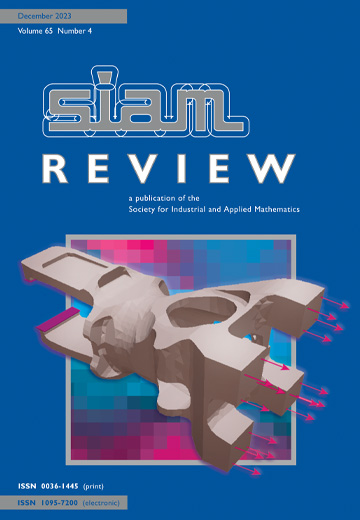Research Spotlights
IF 6.1
1区 数学
Q1 MATHEMATICS, APPLIED
引用次数: 0
Abstract
SIAM Review, Volume 66, Issue 3, Page 479-479, May 2024.Equitable distribution of geographically dispersed resources presents a significant challenge, particularly in defining quantifiable measures of equity. How can we optimally allocate polling sites or hospitals to serve their constituencies? This issue's first Research Spotlight, “Persistent Homology for Resource Coverage: A Case Study of Access to Polling Sites," addresses these questions by demonstrating the application of topological data analysis to identify holes in resource accessibility and coverage. Authors Abigail Hickok, Benjamin Jarman, Michael Johnson, Jiajie Luo, and Mason A. Porter employ persistent homology, a technique that tracks the formation and disappearance of these holes as spatial scales vary. To make matters concrete, the authors consider a case study on access to polling sites and use a non-Euclidean distance that accounts for both travel and waiting times. In their case study, the authors use a weighted Vietoris--Rips filtration based on a symmetrized form of this distance and limit their examination to instances where the approximations underlying the filtration are less likely to lead to approximation-based artifacts. Details, as well as source code, are provided on the estimation of the various quantities, such as travel time, waiting time, and demographics (e.g., age, vehicle access). The result is a homology class that “dies" at time $t$ if it takes $t$ total minutes to cast a vote. The paper concludes with an exposition of potential limitations and future directions that serve to encourage additional investigation into this class of problems (which includes settings where one wants to deploy different sensors to cover a spatial domain) and related techniques. What secrets lurk within? From flaws in human-made infrastructure to materials deep beneath the Earth's land and ocean surfaces to anomalies in patients, our next Research Spotlight, “When Data Driven Reduced Order Modeling Meets Full Waveform Inversion," addresses math and methods to recover the unknown. Authors Liliana Borcea, Josselin Garnier, Alexander V. Mamonov, and Jörn Zimmerling show how tools from numerical linear algebra and reduced-order modeling can be brought to bear on inverse wave scattering problems. Their setup encapsulates a wide variety of sensing modalities, wherein receivers emit a signal (such as an acoustic wave) and a time series of wavefield measurements is subsequently captured at one or more sources. Full waveform inversion refers to the recovery of the unknown “within" and is typically addressed via iterative, nonlinear equations/least-squares solvers. However, it is often plagued by a notoriously nonconvex, ill-conditioned optimization landscape. The authors show how some of the challenges typically encountered in this inversion can be mitigated with the use of reduced-order models. These models employ observed data snapshots to form lower-dimensional, computationally attractive approximations. A key to the paper's developments is a unification of several Galerkin projection--based models and ensuring that these approximation models benefit the inversion. The latter is achieved by having the reduced-order models aimed at capturing “internal waves," and only later addressing the resulting mismatch with the measured data. Through several illustrations, the authors demonstrate how the approach can be deployed. The paper concludes with open questions in the intersection of inverse problems and reduced-order models.
研究热点
SIAM Review》,第 66 卷第 3 期,第 479-479 页,2024 年 5 月。 公平分配地理上分散的资源是一项重大挑战,尤其是在定义可量化的公平衡量标准方面。我们如何才能优化分配投票站或医院,以服务于其服务对象?本期的第一个研究热点是 "资源覆盖的持久同源性":本期的第一个研究热点是 "资源覆盖面的持久同源性:投票站访问案例研究",通过展示拓扑数据分析在识别资源访问性和覆盖面漏洞方面的应用,探讨了这些问题。作者阿比盖尔-希科克(Abigail Hickok)、本杰明-贾曼(Benjamin Jarman)、迈克尔-约翰逊(Michael Johnson)、罗家杰(Jiajie Luo)和梅森-波特(Mason A. Porter)采用了持久同源性技术,该技术可随着空间尺度的变化追踪这些漏洞的形成和消失。为了使问题具体化,作者们考虑了一个关于投票站访问的案例研究,并使用了一种非欧几里得距离来考虑旅行和等待时间。在案例研究中,作者使用了基于该距离对称形式的加权 Vietoris-Rips 过滤,并将其研究限制在过滤所基于的近似值不太可能导致基于近似值的伪影的情况。我们还提供了有关各种量(如旅行时间、等待时间和人口统计学特征(如年龄、车辆使用情况))估算的详细信息和源代码。结果是,如果投票总共需要 $t$ 分钟,则同构类在 $t$ 时间 "死亡"。论文最后阐述了潜在的局限性和未来发展方向,以鼓励对这类问题(包括希望部署不同传感器以覆盖空间领域的情况)和相关技术进行更多研究。内部潜藏着什么秘密?从人造基础设施的缺陷到地球陆地和海洋表面深处的材料,再到病人的异常情况,我们的下一个研究热点 "当数据驱动的降阶建模遇到全波形反演 "将探讨恢复未知的数学和方法。作者 Liliana Borcea、Josselin Garnier、Alexander V. Mamonov 和 Jörn Zimmerling 展示了如何利用数值线性代数和降阶建模工具解决反向波散射问题。他们的设置囊括了各种传感模式,其中接收器发射信号(如声波),随后在一个或多个声源处捕捉波场测量的时间序列。全波形反演是指恢复未知 "内部",通常通过迭代非线性方程/最小二乘求解器来解决。然而,它往往受到众所周知的非凸、条件不佳的优化环境的困扰。作者展示了如何通过使用降阶模型来缓解这种反演中通常会遇到的一些难题。这些模型利用观测到的数据快照形成低维的、计算上有吸引力的近似值。本文发展的关键在于统一多个基于 Galerkin 投影的模型,并确保这些近似模型有利于反演。后者是通过降低阶数模型来捕捉 "内波",然后再解决由此产生的与测量数据不匹配的问题来实现的。作者通过几个例子展示了如何使用这种方法。论文最后提出了反演问题和降阶模型交叉领域的开放性问题。
本文章由计算机程序翻译,如有差异,请以英文原文为准。
求助全文
约1分钟内获得全文
求助全文
来源期刊

SIAM Review
数学-应用数学
CiteScore
16.90
自引率
0.00%
发文量
50
期刊介绍:
Survey and Review feature papers that provide an integrative and current viewpoint on important topics in applied or computational mathematics and scientific computing. These papers aim to offer a comprehensive perspective on the subject matter.
Research Spotlights publish concise research papers in applied and computational mathematics that are of interest to a wide range of readers in SIAM Review. The papers in this section present innovative ideas that are clearly explained and motivated. They stand out from regular publications in specific SIAM journals due to their accessibility and potential for widespread and long-lasting influence.
 求助内容:
求助内容: 应助结果提醒方式:
应助结果提醒方式:


